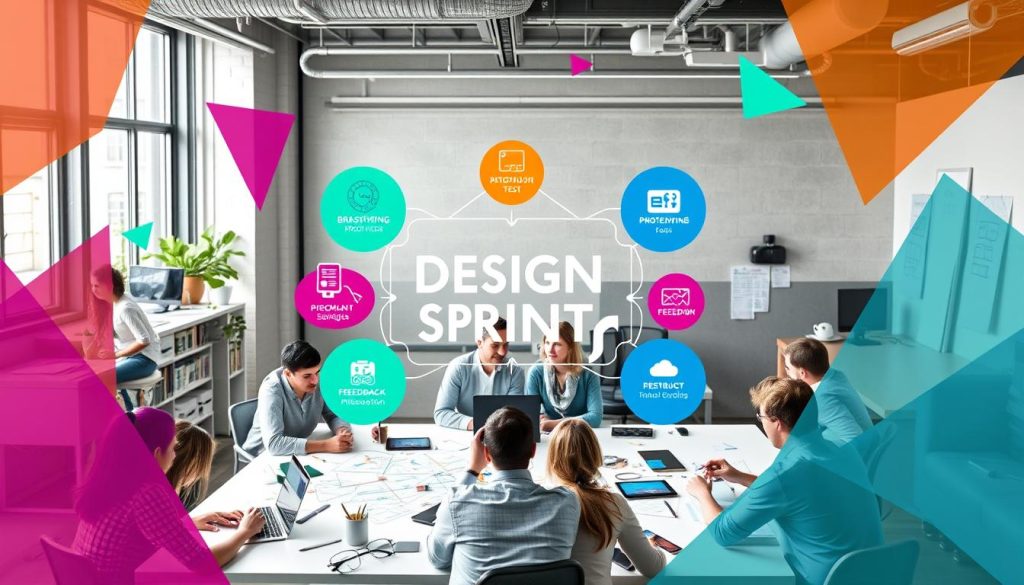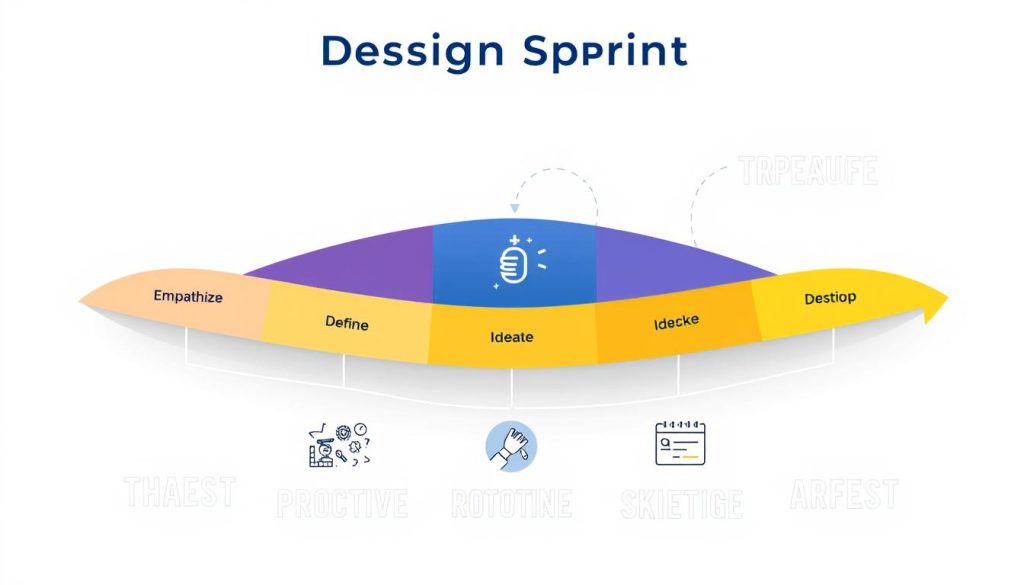Physical Address
304 North Cardinal St.
Dorchester Center, MA 02124
Physical Address
304 North Cardinal St.
Dorchester Center, MA 02124

Ever feel stuck in endless product development with no clear way out? The Google Design Sprint is a game-changer. It changes how businesses tackle tough problems and innovate fast.
Jake Knapp at Google Ventures created this method. It turns months of work into just five days. Teams can quickly test and refine ideas with real users, cutting down risks and speeding up new ideas.
Understanding what a design sprint is, opens up a powerful way to tackle big business challenges. It’s perfect for startups looking for new solutions or big companies wanting to change their ways. This method offers a clear yet flexible path to innovation.
Design sprints are a new way to solve problems. They were created by Jake Knapp at Google Ventures. This method is changing how teams find quick solutions.
Design thinking and practical innovation come together in design sprints. They offer a structured way to go from idea to prototype in just five days. Let’s see how this framework can change your product development and problem-solving ways.
The design sprint idea started at Google. Key moments in its growth include:
Design sprints are based on key ideas for quick innovation:
| Benefit | Impact |
|---|---|
| Reduced Risk | Check ideas before spending a lot |
| Team Alignment | Get everyone on the same page fast |
| Accelerated Innovation | Go from idea to prototype in days |
“Design sprints change how teams innovate, solving big problems quickly.” – Jake Knapp
Using design sprints, your team can solve problems better, take less risk, and work together more. It’s a way to innovate faster and more effectively.

Design sprints are great for solving big problems and finding new ideas. They can change how your team works on tough projects.
Think about using a design sprint in these situations:
“Design sprints compress months of work into a single week, enabling teams to solve critical business problems with unprecedented speed.” – Google Ventures Design Team
Design sprints are perfect for new products, improving services, and big changes. They help you quickly test and improve new ideas.
Signs you might need a design sprint include:
Using design sprints wisely can speed up solving problems, lower risks, and keep your team always looking for new ways to do things.
Design sprints make solving big problems fast and easy. They help teams come up with new ideas quickly. By breaking it down into five steps, teams can tackle challenges and make things better for users.

The design sprint framework is a smart way to solve big business problems. It involves working together and focusing on the task at hand. Each step is important for finding new solutions.
In the first step, your team digs deep into the problem. You’ll look at current issues, gather information, and understand what users need. This is key for starting the rapid prototyping process.
In this phase, your team comes up with lots of ideas. You’ll use methods like crazy eights and mind mapping to explore different solutions.
Next, you’ll pick the best ideas and make a detailed plan. This plan shows how the solution will work and how users will use it.
This step is all about making prototypes. Your team will turn the chosen ideas into real, testable models. These models help you see how the solution might work and make changes as needed.
The last step is to show the prototypes to real users and get their feedback. This feedback helps your team see if their solution works and what needs to be improved.
“Design sprints turn abstract ideas into concrete solutions through structured innovation.” – Google Design Team
| Phase | Key Focus | Duration |
|---|---|---|
| Map and Understand | Problem Definition | 1 Day |
| Sketch and Ideate | Solution Generation | 1 Day |
| Decide and Storyboard | Concept Selection | 1 Day |
| Prototype Solutions | Solution Development | 1-2 Days |
| Test and Validate | User Feedback | 1 Day |
To run a successful design sprint, you need the right tools and resources. These help your team work better together and be more creative. It’s important to pick tools that fit each step of the design sprint.
Digital tools have changed how teams work together, especially when they’re not in the same place. Some great platforms for design sprints include:
For physical tools, you’ll need:
“The right tools can turn a good design sprint into a great innovation journey.” – Design Sprint Expert
Your design sprint toolkit should mix digital ease with hands-on creativity. Here’s a look at some popular design sprint tools:
| Tool | Primary Function | Cost |
|---|---|---|
| Miro | Digital Collaboration | Free/Paid Plans |
| InVision | Prototyping | Paid Subscription |
| Google Workspace | Document Sharing | Free/Paid Tiers |
Pro tip: Always try out your tools before the design sprint. This ensures your team works smoothly and avoids tech problems.
To have a successful google design sprint, you need the right team. The right team can make your innovation process better and lead to new solutions. It’s important to know how each team member works together, their strengths, and how well they can work together.

Building a good team for a google design sprint takes a lot of thought. Your team’s success depends on picking people with different skills and views.
Good design sprint teams have key roles for solving problems well:
Choosing team members needs careful thought. Look for people who:
“A great facilitator turns a good design sprint into an amazing innovation journey.”
The facilitator is key in leading the google design sprint. They are responsible for:
By carefully picking your team and knowing what each member brings, you’re ready for a great design sprint experience.

Design sprints come with their own set of challenges. These can stop even the most determined teams. It’s key to know and tackle these hurdles to succeed.
Teams face several big challenges during design sprints:
“The greatest challenge in design sprints isn’t the process—it’s managing human dynamics and expectations.” – Jake Knapp, Design Sprint Creator
To overcome these challenges, teams need good problem-solving strategies. They should aim for clear communication, structured idea generation, and being flexible.
| Challenge | Impact | Mitigation Strategy |
|---|---|---|
| Time Constraints | Reduced creativity | Strict time-boxing and focused exercises |
| Team Alignment | Conflicting perspectives | Clear role definition and consensus-building techniques |
| Decision Paralysis | Slow progress | Voting mechanisms and facilitator guidance |
By knowing these challenges ahead, teams can prepare strong problem-solving plans. These plans can turn obstacles into chances for new ideas.
Design sprints are key for companies wanting to improve user experience and product development. It’s important to know how well they work to make the most of the effort put in.
To really see how design sprints impact your business, you need a detailed approach. You should have strong ways to measure the real benefits from these focused team efforts.
Choosing the right metrics is crucial to see the results of your design sprint. Important ones include:
When evaluating, focus on both short-term and long-term effects. Use both numbers and feedback to understand more deeply.
| Evaluation Dimension | Assessment Method | Key Metrics |
|---|---|---|
| User Experience | Usability Testing | Task Completion Rates |
| Innovation Potential | Prototype Assessment | Unique Solution Generation |
| Team Collaboration | Sprint Retrospective | Cross-functional Engagement |
Understanding the lasting effects of design sprints requires a strategic view. Look at how these efforts change your company’s ability to innovate.
Design sprints are not just about solving problems—they’re about building a culture of continuous innovation and user-centric thinking.
With strict measurement methods, design sprints can become a key part of your company’s growth strategy.
Design sprints and agile methodology are great ways to develop products. They work well together. This makes your development process more dynamic and innovative.
Adding design thinking to agile makes your product development more focused on users. It’s about mixing agile’s structured flexibility with design sprints’ creative problem-solving.
“Innovation thrives at the intersection of structured methodology and creative thinking.”
Your team can use design sprints as a key tool in agile. This method helps solve complex problems fast and find new solutions.
| Agile Methodology | Design Sprint Integration |
|---|---|
| Iterative Development | Rapid Prototyping and Testing |
| Continuous Improvement | User-Centric Problem Solving |
| Flexible Planning | Creative Solution Generation |
Using both agile and design thinking makes your product development better. It becomes more responsive and innovative. It adapts to user needs and market challenges.
Design sprints have changed how companies make products and solve problems. Looking at real examples shows how fast prototyping and smart innovation work in many fields.
Big companies use design sprints to speed up innovation and cut down on risks. Google, Slack, and Uber are great examples of how this works.
Startups really benefit from design sprints for quick product checks. It helps them test ideas and change plans fast, saving money.
| Startup | Design Sprint Outcome | Impact |
|---|---|---|
| Airbnb | User interface redesign | 25% increase in booking rates |
| Dropbox | Product feature validation | Reduced development time by 40% |
Good design sprints need clear goals, a team with different skills, and focus on users. Rapid prototyping helps cut risks and boost innovation.
“Design sprints transform abstract ideas into tangible solutions faster than traditional methods.” – Jake Knapp, Design Sprint Creator
Companies that use design sprints can make products faster, test ideas quickly, and focus on what users want. This works in many areas.
The Google Design Sprint is a game-changer for tackling tough business problems. It lets your team solve complex issues in just five days. This method is all about quick prototyping, testing, and getting real feedback from users.
Using design sprints can change how you make products. It focuses on solving problems from the user’s point of view. This approach lowers the risks of old development methods. It works for startups and big companies looking for new ideas.
As tech and markets keep changing, design sprints will stay key for smart teams. Being able to adapt fast, test ideas well, and make decisions based on data is crucial. Adopting Google Design Sprints shows you’re serious about always innovating and solving problems quickly.
But, design sprints only work if your team is fully in, has clear goals, and is ready to question the usual ways of doing things. By adding this powerful method to your strategy, you’ll boost creativity, cut down on waste, and speed up making better products.